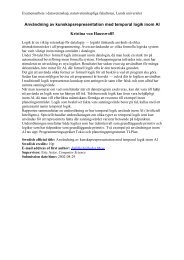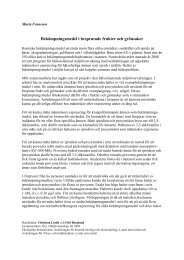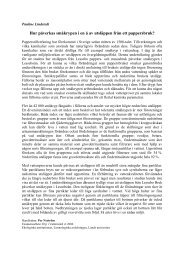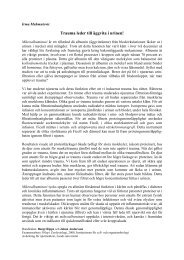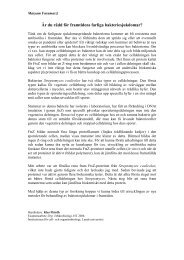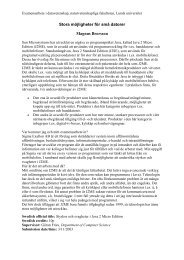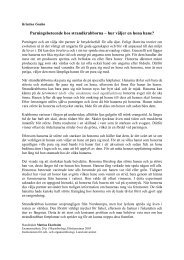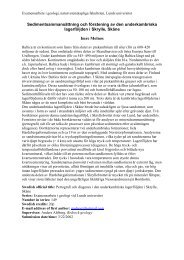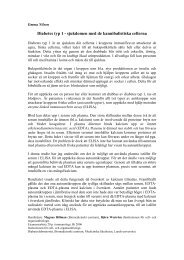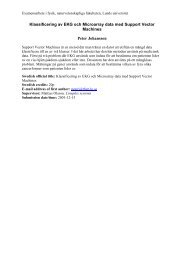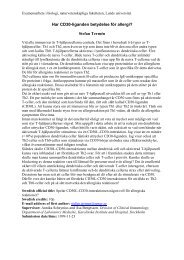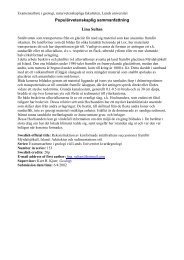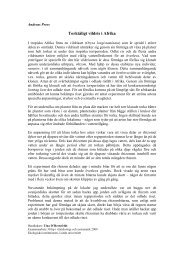Ulrika Johansson - IT - Lunds universitet
Ulrika Johansson - IT - Lunds universitet
Ulrika Johansson - IT - Lunds universitet
Create successful ePaper yourself
Turn your PDF publications into a flip-book with our unique Google optimized e-Paper software.
<strong>Ulrika</strong> <strong>Johansson</strong><br />
Har nya miljögifter upptäckts i Skåne?<br />
I dagens samhälle används ett stort antal kemikalier. För endast en väldigt liten andel av dessa<br />
ämnen har vi idag tillräcklig kunskap om deras egenskaper för att kunna hantera dem på bästa<br />
sätt med avseende på människa och miljö. Alla kemikalier som släpps ut i miljön kan vara<br />
toxiska (giftiga). Toxiciteten beror på i vilken koncentration utsläpp sker, om utsläppen sker i<br />
hög koncentration men under kort tid (akut exponering) eller under lång tid men i låga<br />
koncentrationer (kronisk exponering) och vilken organism som exponeras. I Sverige har 15<br />
miljömål satts upp varav ett är ”Giftfri miljö”. Målet är att inom en generation ska miljön vara<br />
fri från ämnen som är skadliga för människors hälsa eller den biologiska mångfalden. Ett sätt<br />
att försöka uppfylla målet är genom en metod kallad screening.<br />
Screening innebär att man mäter halten av ett antal utvalda ämnen eller ämnesgrupper i olika<br />
matriser (ex. luft, vatten, fisk). I Sverige står Naturvårdsverket varje år för en nationell<br />
screening. De väljer ut vilka ämnen som ska ingå, på vilka lokaler och i vilka matriser prover<br />
ska tas. Ett antal länsstyrelser väljer att delta i regional screening där man väljer ut regionalt<br />
intressanta provpunkter. Under 2004 utfördes en regional screening i Skåne av följande<br />
ämnesgrupper: adipater, siloxaner och klorerade och bromerade styrener. Prover togs i tre<br />
matriser: slam från reningsverk, sediment och fisk i åtta olika kommuner i Skåne.<br />
För att utvärdera resultaten från screeningen gjordes en bedömning av varje ämne inom<br />
respektive ämnesgrupp. Vid denna togs hänsyn till användning av ämnet, registrerad<br />
tillverkning och import i hela Sverige och i Skåne samt användningsområde. Utifrån varje<br />
ämnes kemiska egenskaper kunde den troliga spridningen till olika matriser förutses om<br />
tillräckliga uppgifter fanns. Information om varje ämne söktes i litteratur och olika databaser.<br />
Exempel på information är tidigare uppmätta halter och ekotoxikologiska data.<br />
Ekotoxikologisk data är exempelvis vid vilken koncentration ett ämne dödar hälften av en<br />
testpopulation (så kallat LC 50 -värde). Ett sådant värde ger ett mått på ett ämnes toxicitet och<br />
en låg koncentration indikerar ett toxiskt ämne. Det saknas information om flera av de<br />
ingående ämnena, vilket gör en bedömning svår att göra.<br />
Har då nya miljögifter hittats i Skåne? Flera av de ingående ämnena påvisas ej i Skåne, endast<br />
en adipat och några av siloxanerna utmärker sig genom att påvisas på flera lokaler i slam.<br />
Kunskapen om ämnena är idag för liten för att dra några säkra slutsatser. Dock finns det<br />
frågetecken om deras potentiella negativa effekter på miljön. En del av de ingående ämnena<br />
ingår i ett flertal konsumenttillgängliga produkter. De importeras även som ren råvara till<br />
Sverige. Screeningen visar att de har en stor spridning då de påvisas på flera provlokaler i<br />
Skåne. Sammanfattningsvis är spridningen av flera av ämnena låg. För de ämnen som påvisats<br />
i slam på flera lokaler skulle mer information om ämnena önskas. Fler provtagningar skulle<br />
också kunna vara aktuellt för att tydligare utreda hur spridda ämnena är och i vilka<br />
koncentrationer de finns, i miljön.<br />
Handledare: Olof Berglund<br />
Examensarbete 20 p i ekotoxikologi. Ht 2005<br />
Ekologiska institutionen, Avdelningen för kemisk ekologi och ekotoxikologi, <strong>Lunds</strong> <strong>universitet</strong><br />
Ekosystemteknik, <strong>Lunds</strong> Tekniska Högskola
Summary<br />
In today’s society a wide range of chemicals are used in the industry and in products available<br />
for consumers. All substances that are released in the environment can be toxic for organisms.<br />
The toxicity depends on which organism that is being exposed, the concentration of the<br />
exposure, the route of uptake and if the exposure is chronic or acute. Today we only have<br />
knowledge about chemical properties for a small amount of all used chemicals. It is important<br />
to have knowledge about the properties of a chemical to handle it in the best way concerning<br />
health and environment. One way to get more knowledge about the properties of substances<br />
and the release in the environment is through a method called screening. Screening means that<br />
you measure the concentration of selected chemicals or chemical groups in different matrices.<br />
In Sweden, the Swedish EPA early stands for a national screening and selects the chemicals<br />
that are to be included. County Administrative Board’s choose to participate in regional<br />
screening studies where the Administrative Board in each county select regionally important<br />
sample points. In Scania, samples were taken for three different chemical groups: adipates,<br />
siloxanes and chlorinated and brominated styrenes. The groups chosen in Scania was selected<br />
because the chemicals are assumed to be used or produced in Scania and in such a way that<br />
release to the environment are possible. Another reason is that it is possible to limit the use of<br />
the chemicals if they are found in high concentrations. Samples were taken in three matrices:<br />
sediment, fish and sludge from sewage treatment plant, only sludge samples for adipates.<br />
In this report the following questions have been answered: which substances has been<br />
detected?, are the concentrations low or high compared to the rest of Sweden and other<br />
studies?, is it possible to find a cause to deviating concentrations and can detected<br />
concentrations give environmental consequences? To be able to answer the question if<br />
detected concentrations can give environmental consequences a risk assessment has been<br />
performed. If possible the quotient between MEC (Measured Environmental Concentration)<br />
and PNEC (Predicted No Effect Concentration) has been calculated. A quotient over one<br />
means that negative effects on organisms can occur. It has not always been possible to<br />
calculate the quotient due to insufficient information about the substances.<br />
Of the six adipates included in the study, three are detected. Only one of the adipates is<br />
detected on all sampling points, DEHA. This is an indication of a widespread substance. In<br />
the rest of Sweden, DEHA is detected in sediment- and fish samples, which shows that the<br />
aquatic environment is exposed to DEHA. A quotient between MEC and PNEC has been<br />
calculated, where MEC is the detection limit, and is over one. The other two adipates were<br />
detected at a couple of sample points and the source is probably point sources at these sites.<br />
Several siloxanes are detected at all sampling points in sludge. Cyclic siloxanes are detected<br />
in much higher concentrations than straight. The siloxanes in this study are all volatile<br />
compounds and are mainly spread to the atmosphere. Despite this D5, D6 and MM are<br />
detected in water samples in other parts of Sweden. Due to a lack of knowledge it has not<br />
been possible to make a risk assessment. Only for one of the detected siloxanes, MM, a<br />
MEC/PNEC-quotient has been calculated. The quotient is below one and the risk of negative<br />
effect on aquatic organisms is small. The siloxanes are widespread and are constituents of a<br />
large amount of products available for consumers.<br />
None of the styrenes included in this study were detected in Scania and they are only briefly<br />
discussed in the report.



